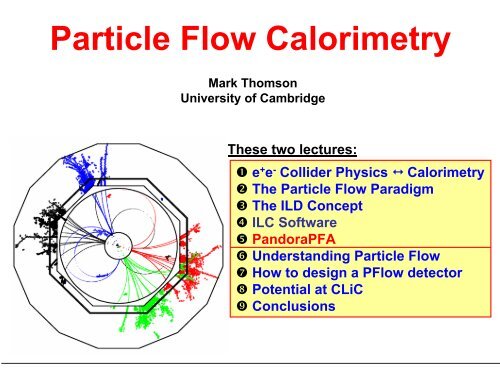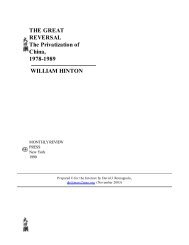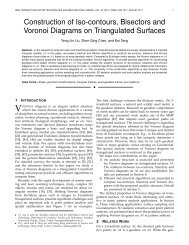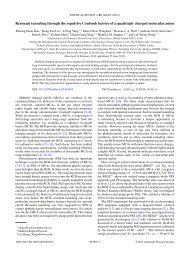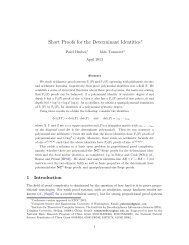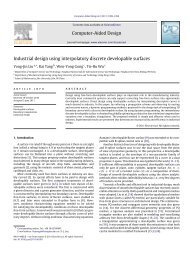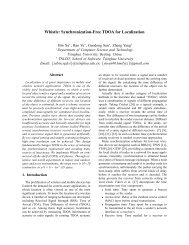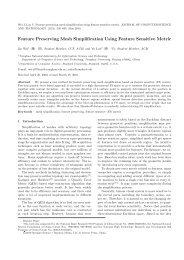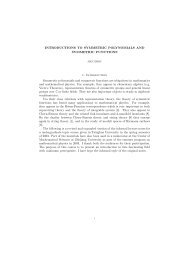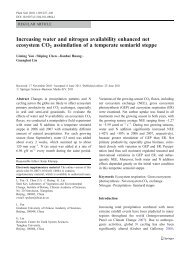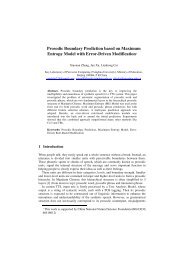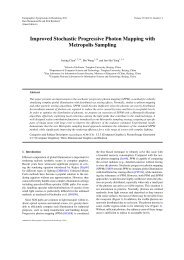Particle Flow Calorimetry and ILC Detector Design - Center for High ...
Particle Flow Calorimetry and ILC Detector Design - Center for High ...
Particle Flow Calorimetry and ILC Detector Design - Center for High ...
Create successful ePaper yourself
Turn your PDF publications into a flip-book with our unique Google optimized e-Paper software.
CCAST-Tsinghua School, 26/4/2009 Mark Thomson 4<strong>ILC</strong> <strong>Calorimetry</strong> GoalsAim <strong>for</strong> jet energy resolution giving di-jet mass resolutionsimilar to Gauge boson widthsFor a pair of jets have:For di-jet mass resolution of order+ term due to θ 12 uncertaintyAssuming a single jet energy resolution with normal stochastic term Typical di-jet energies at <strong>ILC</strong> (100-300 GeV)suggests jet energy resolution goal ofE jj /GeV α(E jj )100 < 27 %200< 38 %
CCAST-Tsinghua School, 26/4/2009 Mark Thomson 5Why is this important ? Direct impact on physics sensitivity, e.g. “WW-scattering”If the Higgs mechanism is notresponsible <strong>for</strong> EWSB thenWW fusion processes importante + e - ννWWννqqqq ,e + e - ννZZννqqqqReconstruction of twodi-jet masses allowsdiscrimination of WW<strong>and</strong> ZZ final statesσ E/E = 0.6/√Eσ E /E = 0.3/√EBest at LEP (ALEPH):σ E/E = 0.6 (1+|cosθ Jet|) /√E(GeV)<strong>ILC</strong> GOAL:σ E/E = 0.3/√E(GeV)
CCAST-Tsinghua School, 26/4/2009 Mark Thomson 6Wantor more correctlyVery hard (may not be possible) to achieve thiswith a traditional approach to calorimetryLimited by typical HCAL resolution of > 50%/√E(GeV)Rememberthis numbera new approach to calorimetry<strong>Particle</strong> <strong>Flow</strong>Dual ReadoutNote: this level of per<strong>for</strong>mance wasn’t necessary at previous colliders
In a typical jet : 60 % of jet energy in charged hadrons 30 % in photons (mainly from ) 10 % in neutral hadrons (mainly <strong>and</strong> ) Traditional calorimetric approach: Measure all components of jet energy in ECAL/HCAL ! ~70 % of energy measured in HCAL: Intrinsically “poor” HCAL resolution limits jet energy resolutionπ + The <strong>Particle</strong> <strong>Flow</strong> ParadigmγnE JET = E ECAL + E HCALE JET = E TRACK + E γ + E n <strong>Particle</strong> <strong>Flow</strong> <strong>Calorimetry</strong> paradigm: charged particles measured in tracker (essentially perfectly) Photons in ECAL: Neutral hadrons (ONLY) in HCAL Only 10 % of jet energy from HCAL much improved resolutionCCAST-Tsinghua School, 26/4/2009 Mark Thomson 7
CCAST-Tsinghua School, 26/4/2009 Mark Thomson 8<strong>Particle</strong> <strong>Flow</strong> <strong>Calorimetry</strong>Hardware:Need to be able to resolve energy deposits from different particles<strong>High</strong>ly granular detectors (as studied in CALICE)Software:Need to be able to identify energy deposits from each individual particle !Sophisticated reconstruction software<strong>Particle</strong> <strong>Flow</strong> <strong>Calorimetry</strong> = HARDWARE + SOFTWARE
CCAST-Tsinghua School, 26/4/2009 Mark Thomson 9<strong>Particle</strong> <strong>Flow</strong> Algorithms (PFA)Reconstruction of a <strong>Particle</strong> <strong>Flow</strong> Calorimeter: Avoid double counting of energy from same particle Separate energy deposits from different particlese.g.If these hits are clustered together withthese, lose energy deposit from this neutralhadron (now part of track particle) <strong>and</strong> ruinenergy measurement <strong>for</strong> this jet.Level of mistakes, “confusion”, determines jet energy resolutionnot the intrinsic calorimetric per<strong>for</strong>mance of ECAL/HCALsounds easy…. PFA per<strong>for</strong>mance depends on detailed reconstruction Relatively new, still developing ideas Output of P<strong>Flow</strong> is a list of reconstructed particles “<strong>Particle</strong> <strong>Flow</strong> Objects” PFOs
CCAST-Tsinghua School, 26/4/2009 Mark Thomson 10 The ILD <strong>Detector</strong> Concept*NOTE:<strong>Particle</strong> flow reconstruction involves “whole detector”To study potential per<strong>for</strong>mance need a detector model,tracking, calorimeters, …<strong>ILC</strong> <strong>Detector</strong> Concepts:Here per<strong>for</strong>mance of particle flow calorimetry shown in thecontext of the ILD detector concept <strong>for</strong> the <strong>ILC</strong> Detailed GEANT 4 detector model exists A potential design <strong>for</strong> an <strong>ILC</strong> detector <strong>Design</strong>ed <strong>for</strong> <strong>Particle</strong> <strong>Flow</strong> calorimetry !ILD Main Features:• Large TPC central tracker (R=1.8 m)• CMS like solenoid (B = 3.5 T)• ECAL <strong>and</strong> HCAL inside solenoid• ECAL/HCAL highly segmented <strong>for</strong> PFA
ILD calorimetry concept*Very high longitudinal <strong>and</strong> transverse segmentationECAL:• SiW sampling calorimeter• Tungsten: X 0 /λ had = 1/25, R Mol. ~ 9mm Narrow EM showers longitudinal sep. of EM/had. showers• longitudinal segmentation: 30 layers• transverse segmentation: 5x5 mm 2 pixelsHCAL:HCAL• Steel-Scintillator sampling calorimeter• longitudinal segmentation: 48 layers (6 interaction lengths)• transverse segmentation: 3x3 cm 2 scintillator tilesECALComments: Technologically feasible (although not cheap) Ongoing test beam studies (CALICE collaboration)*Other ILD calorimetry options being actively studied, e.g. RPC DHCAL, Scintillator strip ECALCCAST-Tsinghua School, 26/4/2009 Mark Thomson 11
CCAST-Tsinghua School, 26/4/2009 Mark Thomson 12Calorimeter Reconstruction <strong>High</strong> granularity calorimeters –very different to previous detectors(except LEP lumi. calorimeters) “Tracking calorimeter” – requiresa new approach to ECAL/HCALreconstruction<strong>Particle</strong> <strong>Flow</strong> ReconstructionPFA calorimetric per<strong>for</strong>mance = HARDWARE + SOFTWAREPer<strong>for</strong>mance will depend on the software algorithmdifficult to evaluate full potentialσ E /E = f (software)
CCAST-Tsinghua School, 26/4/2009 Mark Thomson 13 There are no short cuts, fast simulation doesn’t help…To evaluate <strong>Particle</strong> <strong>Flow</strong> <strong>Calorimetry</strong> at <strong>ILC</strong>:need realistic reconstruction chain>10 years be<strong>for</strong>e start of <strong>ILC</strong> !!! But, as a result of a great deal of work within <strong>ILC</strong> detectorcommunity, we already have a first version…
ILD Software Framework (C++) Everything exists – level of sophistication ~LEP experimentG4 SimulationMokkaFrameworkDigitisationMARLINVarious DigitisersSilicon TrackingLCIO DATATrackingVertexingFlavour TagLEP TPC TrackingFullLDCTrackingLCFIVERTEXPhysics AnalysisClustering<strong>Particle</strong> <strong>Flow</strong>P<strong>and</strong>oraPFA…CCAST-Tsinghua School, 26/4/2009 Mark Thomson 14
http://ilcsoft.desy.de/portalCCAST-Tsinghua School, 26/4/2009 Mark Thomson 16 Marlin framework <strong>and</strong> reconstruction software available from web Simple install script “IlcInstall” Takes just a few hours to configure <strong>and</strong> then just run to getall software <strong>and</strong> associated packages
P<strong>and</strong>oraPFANeed “realistic” <strong>Particle</strong> <strong>Flow</strong> to evaluate potential of method(again no shortcuts)New paradigm – nobody really knows how to approach thisSo where are we now ?Significant ef<strong>for</strong>t in context of <strong>ILC</strong> detector design(~4 groups developing PFA reconstruction worldwide)Concentrate on: P<strong>and</strong>oraPFAThis is still work-in-Progress – currently it gives the bestper<strong>for</strong>manceWill give an overview of the algorithm to highlight howparticle flow reconstruction worksCCAST-Tsinghua School, 26/4/2009 Mark Thomson 17
CCAST-Tsinghua School, 26/4/2009 Mark Thomson 18PFA : Basic issues Separate energy deposits from different particles Avoid double counting of energy from same particle Mistakes drive particle flow jet energy resolutione.g. Need to separate “tracks” (charged hadrons) from photonshardwaregranularitysoftwareP<strong>Flow</strong> Algorithmγγ Need to separate neutral hadrons from charged hadronsIsolated neutral hadron orfragment from shower ?
CCAST-Tsinghua School, 26/4/2009 Mark Thomson 19P<strong>and</strong>oraPFA Overview ECAL/HCAL reconstruction <strong>and</strong> PFA per<strong>for</strong>med in asingle algorithm Fairly generic algorithm• applicable to multiple detector concepts Use tracking in<strong>for</strong>mation to help ECAL/HCAL clustering This is a sophisticated algorithm : 10 4 lines of codeEight Main Stages:i. Track classification/extrapolationii. Loose clustering in ECAL <strong>and</strong> HCALiii. Topological linking of clearly associated clustersiv. Courser grouping of clustersv. Iterative reclusteringvi. Photon Identification/Recoveryvii. Fragment removalviii. Formation of final <strong>Particle</strong> <strong>Flow</strong> Objects(reconstructed particles)
i) TrackingThe use of optimal use of tracking in<strong>for</strong>mation in PFA is essential Non trivial <strong>for</strong> looping tracks (even in a TPC) Matching of tracks to endcap clusters is non-trivial Use of track in<strong>for</strong>mation is a major part of P<strong>and</strong>oraPFA Big ef<strong>for</strong>t to use as many tracks in the event as possible• helps particularly <strong>for</strong> lower energy jets• motivation I : better energy resolution• motivation II : correct measurement of directionTPC-oriented: take advantage of pattern recognition capability(the algorithm would need modification <strong>for</strong> Si tracker)From fully reconstructed LDC tracks identify:V 0 sProngsKinksBackscattersCCAST-Tsinghua School, 26/4/2009 Mark Thomson 20
CCAST-Tsinghua School, 26/4/2009 Mark Thomson 21e.g. Kinks Kink finding extends to “loopers” Can give a measure of missing energy Consider physics hypothesis, e.g.K ± µ ± ν Use Helix fits to start <strong>and</strong> end of tracks toreconstruct missing particle e.g. νp Kp µ Can then reconstruct primary mass If consistent with hypothesis, e.g. m K useprimary track <strong>for</strong> PFO four-momentumP<strong>and</strong>oraPFA reconstructs (some) neutrinos !
CCAST-Tsinghua School, 26/4/2009 Mark Thomson 22ii) ECAL/HCAL Clustering Start at inner layers <strong>and</strong> work outward Tracks can be used to “seed” clusters Associate hits with existing Clusters If no association made <strong>for</strong>m new Cluster Simple cone based algorithm0 1 2 3 4 5 6Simple cone algorithmbased on current direction+ additional N pixelsCones based on either:initial PC direction orcurrent PC directionInitial clusterdirectionUnmatched hits seedsnew clusterParameters:• cone angle• additional pixels
CCAST-Tsinghua School, 26/4/2009 Mark Thomson 23iii) Topological Cluster AssociationBy design, clustering errs on side of cautioni.e. clusters tend to be splitPhilosophy: easier to put things together than split them upClusters are then associated together in two stages:• 1) Tight cluster association – clear topologies• 2) Loose cluster association – fix what’s been missedPhoton IDPhoton ID plays important roleSimple “cut-based” photon ID applied to all clustersClusters tagged as photons are immune from associationprocedure – just left aloneWon’t mergeWon’t mergeCould get mergedγγγ
Clusters associated using a number of topological rulesClear Associations:• Join clusters which are clearly associated making use of highgranularity + tracking capability: very few mistakesLess clear associations:e.g.Proximity7 GeV cluster6 GeV clusterUse E/p consistencyto veto clear mistakes4 GeV trackCCAST-Tsinghua School, 26/4/2009 Mark Thomson 24
Example : MIP segmentsCCAST-Tsinghua School, 26/4/2009 Mark Thomson 25Look at clusters which are consistent with having tracks segments<strong>and</strong> project backwards/<strong>for</strong>ward (defined using local straight-line fitsto hits tagged as MIP-like)Apply tight matching criteria on basis of projected track[NB: + track quality i.e. chi2]Here, association based on “tracking” in calorimeters
CCAST-Tsinghua School, 26/4/2009 Mark Thomson 26iv) Cluster Association Part II• Have made very clear cluster associations• Now try “cruder” association strategies• BUT first associate tracks to clusters (temporary association)• Use track/cluster energies to “veto” associations, e.g.7 GeV cluster6 GeV clusterThis cluster association would be<strong>for</strong>bidden if |E 1+ E 2– p| > 3 σ E5 GeV trackProvides some protection against obvious mistakes
CCAST-Tsinghua School, 26/4/2009 Mark Thomson 27ProximityDistance betweenhits : limited to firstpseudo-layers of clusterShower ConeAssociated if fraction ofhits in cone > some valueShower start identified+Track-Driven Shower ConeApply looser cuts if have low E clusterassociated to high E track
CCAST-Tsinghua School, 26/4/2009 Mark Thomson 28v) Iterative Reclustering Upto this point, in most cases per<strong>for</strong>mance is good –but some difficult cases…30 GeV π +20 GeV n At some point hit the limit of “pure” particle flow just can’t resolve neutral hadron in hadronic showerThe ONLY(?) way to addressthis is “statistically”e.g. if have 30 GeV trackpointing to 20 GeV clusterSOMETHING IS WRONG
CCAST-Tsinghua School, 26/4/2009 Mark Thomson 29 If track momentum <strong>and</strong> cluster energy inconsistent : RECLUSTERe.g.18 GeV30 GeV12 GeV10 GeV TrackChange clustering parameters until cluster splits<strong>and</strong> get sensible track-cluster matchNOTE: NOT FULL PFA as clustering driven by track momentumThis is very important <strong>for</strong> higher energy jets
CCAST-Tsinghua School, 26/4/2009 Mark Thomson 30 Cluster splittingIterative Reclustering StrategiesReapply entire clustering algorithmto hits in “dubious” cluster. Iterativelyreduce cone angle until cluster splitsto give acceptable energy match to track + plug in alternative clustering algorithms Cluster merging with splittingLook <strong>for</strong> clusters to add to a track toget sensible energy association. Ifnecessary iteratively split up clustersto get good match. Track association ambiguitiesIn dense environment may have multipletracks matched to same cluster. Applyabove techniques to get ok energy match.30 GeV38 GeV10 GeV Track30 GeV Track18 GeV12 GeV18 GeV12 GeV 32 GeV “Nuclear Option” If none of above works – kill track <strong>and</strong> rely on clusters alone
vi) Photon ID/Recovery Use simple cut-based photon ID in the early (CPU intensive)stages of P<strong>and</strong>oraPFA In the final stages, use improved photon ID based on theexpected EM longitudinal profile <strong>for</strong> cluster energy E 0 Convert cluster into energy depositions per radiation length(use cluster to determine the layer spacing, i.e. geometry indep.)Cluster profileExpected Shower Profile fixed by cluster energy But fit <strong>for</strong> best shower start, s Normalise areas to unity <strong>and</strong> calc.s Gives a measure of fractional disagreement in obs/exp profiles Use f <strong>and</strong> s to ID photonsCCAST-Tsinghua School, 26/4/2009 Mark Thomson 31
Photon Recovery With cone clustering algorithm, photons close to early showeringcharged hadrons can be merged into a single cluster. Use longitudinal + transverse profile to recover these Essentially, <strong>for</strong> each cluster associated with a track:• project ECAL hits onto plane perpendicular to radial vector topoint where track intersects ECAL• search <strong>for</strong> peaks…vv/cmuTrack intersectsat (0,0)u/cm If there is an isolated peak not associated with “track peak” make newphoton cluster if track energy <strong>and</strong> remaining cluster energy stillstatistically compatible with track momentum + cluster passes photonIDCCAST-Tsinghua School, 26/4/2009 Mark Thomson 32
CCAST-Tsinghua School, 26/4/2009 Mark Thomson 33Use profiles to “dig out” photons overlapping with hadronic clusters:• Also look <strong>for</strong> photons where onlya single peak is found• Implemented by looking atlongitudinal profile of “shower”Only allowed if it results in acceptabletrack-cluster energy consistency…NOTE: in P<strong>and</strong>oraPFA, photon identification is an “iterative”, ratherthan one-off process: different levels of sophisticationapplied at different stages of algorithm
CCAST-Tsinghua School, 26/4/2009 Mark Thomson 34viii) Fragment removal : basic idea Look <strong>for</strong> “evidence” that a cluster is associated with another7 GeV cluster3 GeV6 GeV4 GeV6 GeVcluster9 GeV3 GeV6 GeV9 GeV track9 GeV5 GeV9 GeVDistance of closestapproachLayers in closecontactDistance totrack extrap.Fraction of energyin cone Convert to a numerical evidence score E Compare to another score “required evidence” <strong>for</strong> matching, R,based on change in E/p chi-squared, location in ECAL/HCAL etc. If E > Rthen clusters are merged Rather ad hoc but works well – but works well
Putting it all together…CCAST-Tsinghua School, 26/4/2009 Mark Thomson 35100 GeV Jet If it all works… Reconstruct the individualparticles in the event. Calorimeter energy resolutionnot critical: most energy in<strong>for</strong>m of tracks. Level of mistakes in associatinghits with particles, dominatesjet energy resolution.neutral hadronphotoncharged hadron<strong>Particle</strong> <strong>Flow</strong> ObjectsEnd of Lecture 1
CCAST-Tsinghua School, 26/4/2009 Mark Thomson 36Aside: Analysing PFOs Within Marlin software framework analysis is very easy:void ExampleDSTAnalysis::processEvent( LCEvent * evt ) {typedef const std::vector StringVec ;// loop over collections in eventStringVec* strVec = evt->getCollectionNames() ;<strong>for</strong>(StringVec::const_iterator name=strVec->begin(); name!=strVec->end(); name++){LCCollection* col = evt->getCollection(*name);// find the reconstructed particle flow object collectionif(*name=="P<strong>and</strong>oraPFOs"){<strong>for</strong>(unsigned int i=0;igetElementAt(i));// store PFOs in a vector <strong>for</strong> later analysis_pfovec.push_back(recoPart);}}e.g. to calculate total energy in event:<strong>for</strong>(unsigned int i=0; igetEnergy();
CCAST-Tsinghua School, 26/4/2009 Mark Thomson 37 Current per<strong>for</strong>manceBenchmark per<strong>for</strong>mance using<strong>and</strong> events (clean, no neutrinos)Test at <strong>for</strong> different energies withdecays at restOPAL tune of Pythia fragmentationFull reconstruction (track + calo) usingno Monte Carlo “cheat” in<strong>for</strong>mationNOTE:• Quoting rms of reconstructed energy distribution is misleading• <strong>Particle</strong> <strong>Flow</strong> occasionally goes very wrong tails dominate rms• Conventional to measure per<strong>for</strong>mance using rms90 which isrelatively insensitive to tails
Figures of Merit:rms 90Find smallest region containing90 % of eventsDetermine rms in this regionσ 80Fit sum of two Gaussians with samemean. The narrower one isconstrained to contain 80 % of eventsQuote σ of narrow Gaussian√s = 91 GeVIt turns out that rms 90≈ σ 80(need care when comparing to Gaussian resolution)CCAST-Tsinghua School, 26/4/2009 Mark Thomson 38
CCAST-Tsinghua School, 26/4/2009 Mark Thomson 39 Sligthly confusing but necessary: energy distribution not GaussianTo illustrate the point compare:• P<strong>Flow</strong> reconstructed energy distribution• Gaussian with raw of energy distribution• Gaussion with rms 90 NOTE: FWHM of distribution actually narrower than <strong>for</strong> G(rms 90 )
CCAST-Tsinghua School, 26/4/2009 Mark Thomson 40Per<strong>for</strong>mance (ILD)rms90P<strong>and</strong>oraPFA v03-βE JETσ E /E = α/√E jj|cosθ|
Underst<strong>and</strong>ing PFA Per<strong>for</strong>manceCCAST-Tsinghua School, 26/4/2009 Mark Thomson 41What drives <strong>Particle</strong> <strong>Flow</strong> per<strong>for</strong>mance ? Try to use various “Perfect PFA” algorithms to pin down mainper<strong>for</strong>mance drivers (resolution, confusion, …) Use MC to “cheat” various aspects of <strong>Particle</strong> <strong>Flow</strong>P<strong>and</strong>oraPFA options:• PerfectPhotonClusteringhits from photons clustered using MC info<strong>and</strong> removed from main algorithm• PerfectNeutralHadronClusteringhits from neutral hadrons clusteredusing MC info…• PerfectFragmentRemovalafter P<strong>and</strong>oraPFA clustering “fragments”from charged tracks identified from MC <strong>and</strong>added to charged track cluster• PerfectPFAperfect clustering <strong>and</strong> matching to tracks+++
CCAST-Tsinghua School, 26/4/2009 Mark Thomson 42Contributionσ E/E45 GeV 100 GeV 180 GeV 250 GeVCalo. Resolution 3.1 % 2.1 % 1.5 % 1.3 %Leakage 0.1 % 0.5 % 0.8 % 1.0 %Tracking 0.7 % 0.7 % 1.0 % 0.7 %Photons “missed” 0.4 % 1.2 % 1.4 % 1.8 %Neutrals “missed” 1.0 % 1.6 % 1.7 % 1.8 %Charged Frags. 1.2 % 0.7 % 0.4 % 0.0 %“Other” 0.8 % 0.8 % 1.2 % 1.2 %Comments: For 45 GeV jets, jet energy resolution dominated by ECAL/HCAL resolution Track reco. not a large contribution (Reco ≈ CheatedTracking) “Satellite” neutral fragments not a large contribution• efficiently identified Leakage only becomes significant <strong>for</strong> high energies Missed neutral hadrons dominant confusion effect Missed photons, important at higher energies
CCAST-Tsinghua School, 26/4/2009 Mark Thomson 43
CCAST-Tsinghua School, 26/4/2009 Mark Thomson 44LeakageTwo interesting questions: How important is HCAL leakage ?• vary number of HCAL layers What can be recovered using MUON chambers as a “Tail catcher”• P<strong>and</strong>oraPFA now includes MUON chamber reco.• Switched off in default version• Simple st<strong>and</strong>alone clustering (cone based)• Fairly simple matching to CALO clusters (apply energy/momentum veto)• Simple energy estimator (digital) + some estimate <strong>for</strong> loss in coile.g.The problem
HCAL Depth ResultsCCAST-Tsinghua School, 26/4/2009 Mark Thomson 45• Open circles = no use of muon chambers as a “tail-catcher”• Solid circles = including “tail-catcher”HCALλ ILayers HCAL +ECAL32 4.0 4.838 4.7 5.543 5.4 6.248 6.0 6.863 7.9 8.7ECAL : λ I = 0.8HCAL : λ I includes scintillator Little motivation <strong>for</strong> going beyond a 48 layer (6 λ Ι) HCAL Depends on Hadron Shower simulation “Tail-catcher”: corrects ~50% effect of leakage, limited by thick solenoidFor 1 TeV machine “reasonable range” ~ 40 – 48 layers (5 λ Ι -6 λ Ι )
Optimisation of a <strong>Particle</strong> <strong>Flow</strong> detectorCCAST-Tsinghua School, 26/4/2009 Mark Thomson 46 <strong>Particle</strong> <strong>Flow</strong> <strong>Calorimetry</strong> lives or dies on ability to separateenergy deposits from individual particles.• Large detector – spatially separate particles• <strong>High</strong> B-field – separate charged/neutrals• <strong>High</strong> granularity ECAL/HCAL – resolve particlesRSeparation of charge/neutralsBRMight expect “figure-of-merit”:2σ Argues <strong>for</strong>: large + high granularity + B Cost considerations: small + lower granularity + BCalorimeter granularity/R MoliereOptimise detector parameters using P<strong>and</strong>oraPFA! Interpretation: observing effects of detector + imperfect software
Cost drivers:e.g. Radius vs. B-field• For <strong>Particle</strong> flow, ECAL <strong>and</strong> HCAL inside Solenoid• Calorimeters <strong>and</strong> solenoid are the main cost drivers of an <strong>ILC</strong>detector optimised <strong>for</strong> particle flow• Cost of calorimeters scales with active area• Cost of solenoid scales with stored energy, (very approx.)TPC radius <strong>and</strong> B-field play major role in total detector cost• Study jet energy resolution as a function of B <strong>and</strong> RCCAST-Tsinghua School, 26/4/2009 Mark Thomson 47
PFA Optimisation: B vs Radius Vary B <strong>and</strong> R Empirically findResolution Tracking Leakage Confusion Conclude:• R is more important than B <strong>for</strong> PFA per<strong>for</strong>mance• Confusion term ∝ B -0.3 R -1• 1/R makes sense – it’s just geometryCCAST-Tsinghua School, 26/4/2009 Mark Thomson 48
CCAST-Tsinghua School, 26/4/2009 Mark Thomson 49How important is segmentation ?1x1 3x3 5x5 10x10HCALPreliminary• 3×3cm 2 looks reasonable• Hint of gain going to 1×1cm 2• Significant degradation <strong>for</strong>larger tile sizes, e.g. 5×5cm 2
CCAST-Tsinghua School, 26/4/2009 Mark Thomson 50<strong>and</strong> ECAL Segmentation ? Investigate 10×10mm 2 , 20×20mm 2 <strong>and</strong> 30×30mm 2• Note: retuned P<strong>and</strong>oraPFA clustering parametersPreliminary Per<strong>for</strong>mance is a strong function of pixel size <strong>High</strong> ECAL segmentation is vital <strong>for</strong> PFACaveat:!• Remember results are algorithm dependent• Could reflect flaw in reconstructionNevertheless: highly segmented HCAL/ECAL clearly essential
<strong>Particle</strong> <strong>Flow</strong> can deliver <strong>ILC</strong> jet energy goals Whole detector concepts studied, <strong>and</strong> (partially) optimisede.g. ILD What about <strong>Particle</strong> <strong>Flow</strong> <strong>for</strong> higher energy machines ?CCAST-Tsinghua School, 26/4/2009 Mark Thomson 51
CCAST-Tsinghua School, 26/4/2009 Mark Thomson 52 <strong>Particle</strong> <strong>Flow</strong> at CLIC <strong>Particle</strong> <strong>Flow</strong> can deliver <strong>ILC</strong> jet energy goals <strong>Detector</strong> concepts studied, <strong>and</strong> (partially) optimisede.g. ILD What about <strong>Particle</strong> <strong>Flow</strong> <strong>for</strong> CLIC ?STEP 1: take ILD <strong>and</strong> run…500 GeV Jet500 GeV Jet
General ConsiderationsCCAST-Tsinghua School, 26/4/2009 Mark Thomson 53Traditional calorimetryDoes not degrade significantlywith energy (but leakage will be important at CLIC)<strong>Particle</strong> flow gives much betterper<strong>for</strong>mance at “low” energies• very promising <strong>for</strong> <strong>ILC</strong>What about at CLiC ?PFA perf. degrades with energyFor 500 GeV jets, current alg.<strong>and</strong> ILD concept:Crank up field, HCAL depth…rms90E JETP<strong>and</strong>oraPFA v03-βσ E /E = α/√E jj|cosθ|
CCAST-Tsinghua School, 26/4/2009 Mark Thomson 54 For 1 TeV jets, particle flow will not give(probably substantially worse) This is probably not a problem <strong>for</strong> two reasonsi) Not interested in 1 TeV jets:most interesting physics likely to be 6, 8, ... fermion final statesFor 0.5 TeV jets, particle flow likely to be comparable or betterthan a traditional calorimetric approachii) A P<strong>Flow</strong> calorimeter still has good calorimetric resolutioncan design algorithm to move away from particle flow athigher energies<strong>Particle</strong> <strong>Flow</strong> Energy <strong>Flow</strong> Calo Energy Could be adapted on event, jet, locality basis Energy flow “trivial” to implement in P<strong>and</strong>oraPFA An adaptive algorithm should not be too difficult…But, a particle flow detector is expensive: possible to justify cost ?
CCAST-Tsinghua School, 26/4/2009 Mark Thomson 55Physics ConsiderationsWhether particle flow is appropriate <strong>for</strong> a multi-TeV e + e – colliderneeds detailed study but depends on physics program, e.g. CLIC is unlikely to operate solely at the highest energy Likely to be a rich physics program below max. energy• lower to study Higgs, SUSY threshold scans, etc.• Here <strong>Particle</strong> <strong>Flow</strong> <strong>Calorimetry</strong> highly desirableFor high energy running what are the calorimetry goals ? For <strong>ILC</strong> reasonably well defined, wish to separate W/Z For CLIC, less clear <strong>and</strong> again depends on physics program What is most important:• direct reconstruction of high mass particles• What jet energy scale ? Not• For 6 fermion final states current PFA already competitive (ILD+)• What mass resolution is needed ?• For 1TeV particle, e.g. decayingat rest current PFA + ILD detector:• Missing transverse energy (i.e. p T) resolution ?• W/Z separation ?
W/Z Separation at high EnergiesCCAST-Tsinghua School, 26/4/2009 Mark Thomson 56On-shell W/Z decay topology depends on energy:LEP<strong>ILC</strong>CLIC<strong>Particle</strong> flow reco.might help hereA few comments:•<strong>Particle</strong> multiplicity does not change•Boost means higher particle density•PFA could be better <strong>for</strong> “mono-jet” mass resolutionP<strong>and</strong>oraPFA + ILD per<strong>for</strong>mance studied <strong>for</strong>:125 GeV Z 250 GeV Z 500 GeV Z 1 TeV Z
CCAST-Tsinghua School, 26/4/2009 Mark Thomson 57 Study Z mass resolution as function of E Zwith ILD detector (TPC based, B=3.5 T, 6 λ IHCAL)rms90P<strong>and</strong>oraPFA v03-βE Z σ E /E σ m/ m125 GeV 2.4 % 2.7 %250 GeV 2.5 % 3.1 %500 GeV 3.1 % 4.1 %1 TeV 4.2 % 6.2 %1.5 TeV 5.6 % 8.2 %
Conclusions <strong>Particle</strong> <strong>Flow</strong> at the <strong>ILC</strong>Now have a proof of principle of <strong>Particle</strong> <strong>Flow</strong> <strong>Calorimetry</strong>Unprecedented Jet Energy Resolution• Based on full simulation/reconstruction (gaps <strong>and</strong> all)of ILD detector conceptPFLOW drives design of <strong>ILC</strong> <strong>Detector</strong>s: ILD <strong>and</strong> SiD <strong>Particle</strong> <strong>Flow</strong> at CLIC<strong>Particle</strong> <strong>Flow</strong> <strong>Calorimetry</strong> certainly not ruled out• Need to consider in context of the full CLIC physics programme- what drives jet energy resolution goals at CLIC ?• For Higgs + threshold studies, CLIC would be likely to run at lowerenergy: here there is a strong argument <strong>for</strong> PFA• For mono-jet mass resolution, PFA may help at high energies(needs study)• Perhaps surprisingly, ILD detector concept looks like it will give “OK”per<strong>for</strong>mance <strong>for</strong> 500 GeV jets <strong>and</strong> 1 TeV Zs: i.e. TPC, 3.5 T, 6 λ ICCAST-Tsinghua School, 26/4/2009 Mark Thomson 58
Thank youCCAST-Tsinghua School, 26/4/2009 Mark Thomson 59


